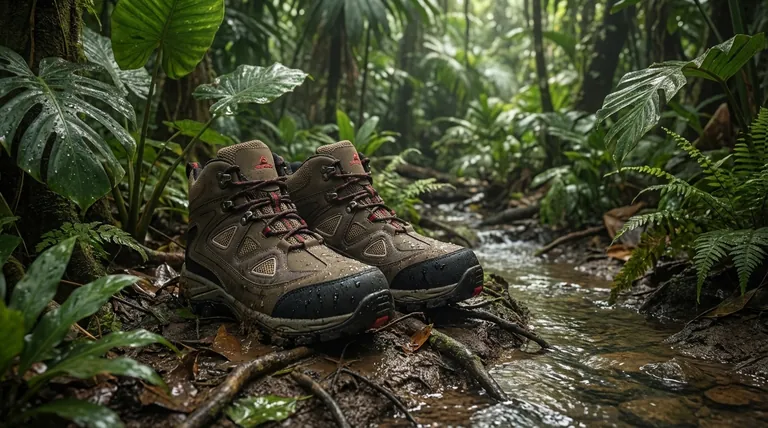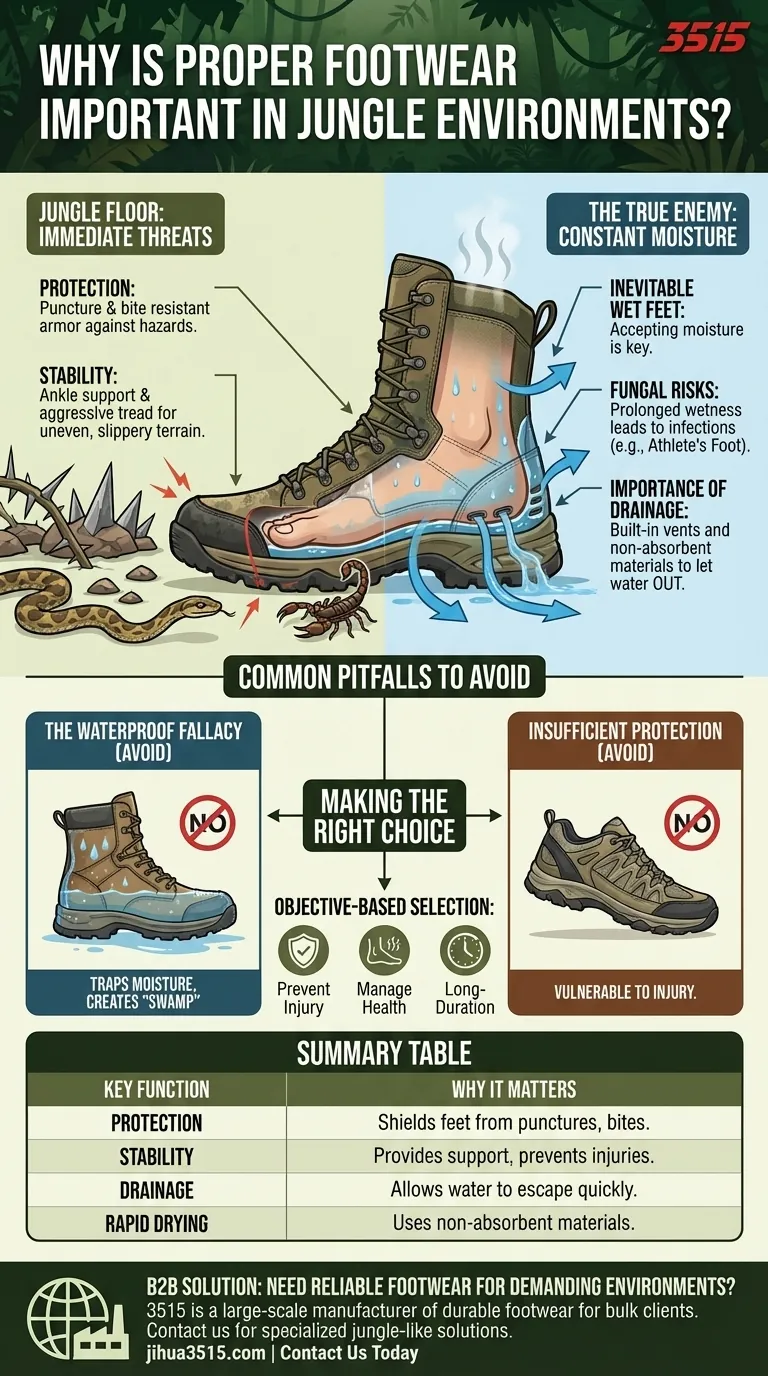In a jungle environment, proper footwear is your most critical piece of equipment. It serves as the primary line of defense for your feet, which are in constant contact with a hazardous landscape. The right boots are not about comfort, but about preventing immediate physical injury from the terrain and mitigating the long-term health risks posed by perpetual moisture.
The core purpose of jungle footwear is not to keep your feet dry—an impossible goal—but to protect them from physical harm while allowing water to drain and the foot to dry as quickly as possible. This principle of protection and rapid drainage is fundamental to preventing debilitating injuries and infections.

The Jungle Floor: A Landscape of Immediate Threats
Protection from Punctures and Bites
The ground in a jungle is littered with hazards. Specialized footwear with durable soles and tough uppers acts as essential armor against sharp spikes, rocks, and the bites of venomous creatures like snakes, scorpions, and ants.
This physical barrier is the first and most obvious function of a proper boot, preventing injuries that could quickly become infected in a humid environment.
Stability and Ankle Support
Jungle terrain is relentlessly uneven, often covered in slippery mud, roots, and vegetation. A sturdy boot provides crucial ankle support to prevent sprains and fractures, which can be incapacitating far from any medical aid.
The aggressive tread on a jungle boot is designed to provide maximum traction, giving you a stable platform to navigate treacherous slopes and slick surfaces safely.
The True Enemy: Constant Moisture
The Inevitability of Wet Feet
Between frequent rain, river crossings, and intense humidity that limits the evaporation of sweat, your feet will get wet. Accepting this fact is the first step in understanding proper jungle foot care.
Attempting to keep feet completely dry with waterproof gear is a failing strategy that often creates more significant problems.
The Risk of Fungal Infections
Prolonged exposure to moisture softens the skin on your feet, making it highly susceptible to blisters, abrasions, and fungal infections like athlete's foot (Tinea pedis).
These conditions are not minor annoyances; they can be extremely painful and lead to secondary bacterial infections that can end an expedition or mission.
The Importance of Drainage
Since you cannot keep water out, the best jungle boots are designed to let it out. They feature built-in drainage vents or use non-absorbent materials that push water out with every step.
This design philosophy, perfected in military jungle combat boots (JCBs), allows your feet and socks to begin drying the moment you stop moving, drastically reducing the risk of skin breakdown.
Common Pitfalls to Avoid
The Waterproof Boot Fallacy
Using waterproof-lined boots (e.g., Gore-Tex) is one of the most common and dangerous mistakes in a jungle. While they block external water, they also trap sweat and any moisture that inevitably gets in over the top.
This creates a "swamp" inside your boot, accelerating skin decay and creating the perfect breeding ground for fungus. They are the wrong tool for a hot, wet environment.
Insufficient Protection
Lightweight hiking shoes or trail runners, while comfortable, often lack the durability and protection needed. Their softer soles are more vulnerable to punctures, and they offer minimal defense against snakebites or ankle injuries.
Making the Right Choice for Your Goal
The right footwear is a system that must match your objective. Consider your specific needs when making a selection.
- If your primary focus is preventing physical injury: Prioritize a boot with a puncture-resistant sole, durable upper materials, and substantial ankle support.
- If your primary focus is managing foot health: Choose a boot known for its rapid-drying, non-absorbent materials and effective drainage vents.
- If your primary focus is long-duration effectiveness: Combine a proper jungle boot with high-quality, moisture-wicking socks and a strict foot care discipline of cleaning and drying your feet at every opportunity.
Ultimately, selecting the right footwear is a strategic decision that directly impacts your safety, health, and overall effectiveness in a jungle environment.
Summary Table:
| Key Function | Why It Matters |
|---|---|
| Protection | Shields feet from punctures, bites, and sharp objects on the jungle floor. |
| Stability | Provides ankle support and traction on uneven, slippery terrain to prevent injuries. |
| Drainage | Allows water to escape quickly, reducing the risk of fungal infections from constant moisture. |
| Rapid Drying | Uses non-absorbent materials to help feet and socks dry faster when not moving. |
Need reliable footwear for demanding environments?
As a large-scale manufacturer, 3515 produces a comprehensive range of durable footwear for distributors, brand owners, and bulk clients. Our production capabilities encompass all types of specialized shoes and boots, including those designed for jungle-like conditions with an emphasis on protection, stability, and rapid drainage.
Contact us today to discuss your specific needs and discover how we can provide the right footwear solution for your market.
Visual Guide

Related Products
- Safety Footwear Wholesale Manufacturer for Custom OEM/ODM Production
- Durable Rubber Sole Outdoor Shoes Wholesale & Custom Manufacturing
- Wholesale Safety Footwear Manufacturer for Bulk & Custom OEM Orders
- Custom OEM Training Shoes Wholesale Manufacturer Durable & Breathable
- Premium Suede Sport Safety Shoes for Wholesale & Bulk Orders
People Also Ask
- What do heavy duty boots do? Protect Your Feet in Demanding Work Environments
- What are OSHA approved shoes? Understanding the Correct Standards for Workplace Safety
- What cultural and environmental considerations are tied to wearing shoes indoors? Balance Hygiene, Tradition, and Foot Health
- What are the differences between steel toe, composite toe, and alloy toe Wellington boots? Choose the Right Safety Toe for Your Job
- How long can you wear safety boots? The Lifespan is Determined by Wear, Not Time



















